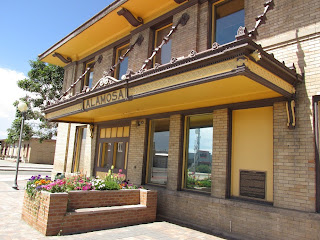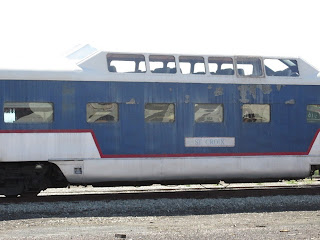If your western road trip takes you to southern Colorado you'll be traveling in an area of the U.S. where the Great Southwest meets the Rocky Mountains. One town in particular you'll want to add to your trip planner is Alamosa Colorado.
 |
| Downtown Alamosa Colorado |
The Railroad Made Alamosa
Alamosa Colorado is one of those many towns in the western U.S. who owes it's original growth to the railroad. Where the early railroad built to, in many instances, determined what towns prospered and what towns did not. In the case of Alamosa, the real engine of growth was the Denver and Rio Grande Western Railroad which built to it in June of 1878 from Garland Colorado to the east and eventually continued onward. To emphasize the importance of the railroad to Alamosa, the town today calls itself "the town that grew overnight". The Denver and Rio Grande Western Railroad changed a tent settlement to a solid town literally overnight. It's said that whole buildings were transported to Alamosa on rail cars and the town incorporated in August of 1878.
 |
| Historic Alamosa Colorado train depot |
Alamosa Colorado is located in the San Luis Valley where agriculture is the major economic catalyst. The San Luis Valley is about 125 miles long and about 50 miles wide. To the east are the towering Sangre de Cristo Range and to the west are the San Juan Mountains. At one time the valley was inhabited by both the Comanche and Ute Indians who hunted game such as deer and elk.
The Spaniard, Diego de Vargas, was the first European to enter the valley. Lieutenant Zebulon Pike’ s expedition traveled through the San Luis Valley while still a Spanish territory in 1806-1807. After the end of the Spanish American War in the 1840's the region became a territory of the United States.
This valley receives it's irrigation from the Rio Grande and from artesian wells which makes it the most productive agricultural valley in all of Colorado. Lettuce, barley and Red McClure potatoes are some of the main crops shipped out of the San Luis Valley.
The San Luis Valley is a unique region. The valley lies in elevations above 7,000 feet and in many respects is a high desert but lies above aquifers. By the end of the 1800's most of the valley had been cultivated.
When the Denver and Rio Grande Western Railroad built into town it made Alamosa a major shipping point for the valley's crops.
 |
| Rio Grande Scenic Railroad locomotive |
Alamosa, which means cottonwood in Spanish, is the place to stay when visiting nearby attractions including the Great Sand Dunes National Park which is located about thirty-eight miles northeast of town. These are the tallest sand dunes in America and if you've never visited this area you'll want to add it to your western vacation planner. Camping is allowed inside the park and there are room accommodations just outside the park entrance.
Another very popular attraction in Alamosa itself is the Rio Grande Scenic Railroad. This excursion train rides from Alamosa to La Veta Colorado and a connection to the Cumbres and Toltec Railway which offers scenic rides to Chama New Mexico. The Rio Grande Scenic Railroad route takes you through fascinating mountain country that's not seen from the highway.
 |
| Vintage rail cars at Alamosa railyard |
The Alamosa National Wildlife Refuge was established in 1962 as a haven for migratory birds and other wildlife. The refuge is over 11,000 acres in size. According to the U.S. Fish & Wildlife Service, the refuge consists of wet meadows, river oxbows and riparian corridor primarily within the flood plain of the Rio Grande, and dry uplands vegetated with greasewood and saltbush. These areas support songbirds, water birds, raptors, mule deer, beaver and coyotes.
The Monte Vista National Wildlife Refuge was established in 1953 particularly as a haven for waterfowl. The U.S. Fish & Wildlife Service state that the refuge is a major stopover for migrating greater sandhill cranes moving between their wintering area around Bosque del Apache National Wildlife Refuge in New Mexico and breeding grounds in the northern United States and southern Canada. There is also a great number of elk seen in this refuge. As is the case with the valley's agriculture, the water provided by the Rio Grande and the underground aquifers make both the Alamosa National Wildlife Refuge and the Monte Vista National Wildlife Refuge possible.
While searching for oil during the 1930's, hot water was struck near Hooper Colorado to the north of Alamosa. Today the Alamosa area offers visitors a very unique mineral water swimming pool. The Sand Dunes Swimming Pool and RV Park offers a 150,000 gallon pool where underground hot springs water enters the pool at 118 degrees Fahrenheit and is maintained in the pool between 98 and 100 degrees. There is an adjoining 24 person therapy pool whose temperature stays a consistent 108 to 109 degrees. The pool also offers an excellent snack bar, family fun, relaxation and rejuvenation and it's just 20 miles from Alamosa. It's a great stop to add to your itinerary when visiting all of the other attractions in and around Alamosa Colorado.
 |
| Great Sand Dunes National Park |
Great Sand Dunes National Park
A Visit to the Cave Dwellings at Mesa Verde
The Great Sand Dunes National park is just about a 45 minute drive northeast of Alamosa Colorado. Mesa Verde national park is just west of Durango Colorado which is another must stop while in southern Colorado and about 180 miles west of Alamosa. The drive from Alamosa to Mesa Verde is about three and a half hours.
(Article and photos copyright 2013 Western Trips)

